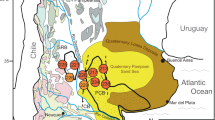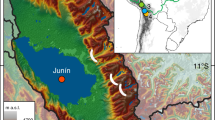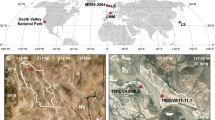Abstract
Climate strongly affects the production of sediment from mountain catchments as well as its transport and deposition within adjacent sedimentary basins1,2,3. However, identifying climatic influences on basin stratigraphy is complicated by nonlinearities, feedback loops, lag times, buffering and convergence among processes within the sediment routeing system3,4. The Palaeocene/Eocene thermal maximum (PETM) arguably represents the most abrupt and dramatic instance of global warming in the Cenozoic era and has been proposed to be a geologic analogue for anthropogenic climate change5. Here we evaluate the fluvial response in western Colorado to the PETM. Concomitant with the carbon isotope excursion marking the PETM we document a basin-wide shift to thick, multistoried, sheets of sandstone characterized by variable channel dimensions, dominance of upper flow regime sedimentary structures, and prevalent crevasse splay deposits. This progradation of coarse-grained lithofacies matches model predictions for rapid increases in sediment flux and discharge1,3, instigated by regional vegetation overturn5,6 and enhanced monsoon precipitation7,8. Yet the change in fluvial deposition persisted long after the approximately 200,000-year-long PETM9 with its increased carbon dioxide levels in the atmosphere, emphasizing the strong role the protracted transmission of catchment responses to distant depositional systems has in constructing large-scale basin stratigraphy. Our results, combined with evidence for increased dissolved loads10 and terrestrial clay export5,11,12 to world oceans, indicate that the transient hyper-greenhouse climate of the PETM may represent a major geomorphic ‘system-clearing event’13, involving a global mobilization of dissolved and solid sediment loads on Earth’s surface.
This is a preview of subscription content, access via your institution
Access options
Subscribe to this journal
Receive 51 print issues and online access
$199.00 per year
only $3.90 per issue
Buy this article
- Purchase on Springer Link
- Instant access to full article PDF
Prices may be subject to local taxes which are calculated during checkout




Similar content being viewed by others
References
Paola, C., Heller, P. L. & Angevine, C. L. The large-scale dynamics of grain-size variation in alluvial basins, 1: Theory. Basin Res. 4, 73–90 (1992)
Tucker, G. E. & Slingerland, R. Drainage basin responses to climate change. Wat. Resour. Res. 33, 2031–2047 (1997)
Armitage, J. J., Duller, R. A., Whittaker, A. C. & Allen, P. A. Transformation of tectonic and climatic signals from source to sedimentary archive. Nature Geosci. 4, 231–235 (2011)
Allen, P. A. in Landscape Evolution: Denudation, Climate and Tectonics Over Different Time and Space Scales Vol. 269 (eds Gallacher, K., Jones, K. S. J. & Wainwright, J. ) 7–28 (Geological Society Special Publications, 2008)
McInerney, F. A. & Wing, S. L. The Paleocene-Eocene Thermal Maximum: a perturbation of carbon cycle, climate, and biosphere with implications for the future. Annu. Rev. Earth Planet. Sci. 39, 489–516 (2011)
Wing, S. L. et al. Transient floral change and rapid global warming at the Paleocene-Eocene boundary. Science 310, 993–996 (2005)
Shellito, C. J., Sloan, L. C. & Huber, M. Climate model sensitivity to atmospheric CO2 levels in the early-middle Paleogene. Palaeogeogr. Palaeoclimatol. Palaeoecol. 193, 113–123 (2003)
Winguth, A., Shellito, C., Shields, C. & Winguth, C. Climate response at the Paleocene Eocene Thermal Maximum to greenhouse gas forcing—a model study with CCSM3. J. Clim. 23, 2562–2584 (2010)
Murphy, B. H., Farley, K. A. & Zachos, J. C. An extraterrestrial 3He-based timescale for the Paleocene-Eocene Thermal Maximum (PETM) from Walvis Ridge, IODP Site 1266. Geochim. Cosmochim. Acta 74, 5098–5108 (2010)
Ravizza, G., Norris, R. N., Blusztajn, J. & Aubry, M.-P. An osmium isotope excursion associated with the late Paleocene thermal maximum: evidence of intensified chemical weathering. Paleoceanography 16, 155–163 (2001)
Robert, C. & Kennett, J. P. Antarctic subtropical humid episode at the Paleocene–Eocene boundary—clay mineral evidence. Geology 22, 211–214 (1994)
Gibson, T. G., Bybell, L. M. & Mason, D. B. Stratigraphic and climatic implications of clay mineral changes around the Paleocene/Eocene boundary of the northeastern US margin. Sedim. Geol. 134, 65–92 (2000)
Jerolmack, D. J. & Paola, C. Shredding of environmental signals by sediment transport. Geophys. Res. Lett. 37, L19401 (2010)
Dickinson, W. R. et al. Paleogeographic and paleotectonic setting of Laramide sedimentary basins in the central Rocky Mountain region. Geol. Soc. Am. Bull. 100, 1023–1039 (1988)
Johnson, R. C. & May, F. Preliminary stratigraphic studies of the upper part of the Mesaverde Group, the Wasatch Formation, and the lower part of the Green River Formation, DeBeque area, Colorado, including environments of deposition and investigation of palynomorph assemblages. USGS Misc. Field Investig. Map MF-1050. (1978)
Johnson, R. C. & Flores, R. M. in Piceance Basin 2003 Guidebook (eds Peterson, K. M., Olson, T. M. & Anderson, D. A. ) 21–61 (RMAG, 2003)
Burger, B. J. & Honey, J. G. Plesiadapidae (Mammalia, Primates) from the late Paleocene Fort Union Formation of the Piceance Creek Basin, Colorado. J. Vert. Paleo. 28, 816–825 (2008)
Lorenz, J. C. & Nadon, G. C. Braided-river deposits in a muddy depositional setting: the Molina Member of the Wasatch Formation (Paleogene) west-central Colorado, U.S.A. J. Sedim. Res. 72, 376–385 (2002)
Lillegraven, J. A. & Ostresh, L. M., Jr in Dawn of the Age of Mammals in the northern part of the Rocky Mountain Interior, North America Vol. 243 (eds Bown, T. M. & Rose, K. D. ) 1–30 (Geological Society of America, GSA Special Paper, 1990)
Dickinson, W. R. & Gehrels, G. E. U-Pb ages of detrital zircons from Permian and Jurassic eolian sandstones of the Colorado Plateau, USA: paleogeographic implications. Sedim. Geol. 163, 29–66 (2003)
Blecha, A. M. & Gardner, M. H. Quantifying tectonic and climatic controls on alluvial architecture: Wasatch Formation of western Colorado. GSA Abstr. Progr. 36, 307 (2004)
Johnson, S. Y. Phanerozoic evolution of sedimentary basins in the Uinta-Piceance Basin region, northwestern Colorado and northeastern Utah. USGS Bull. 1787-FF, FF1–FF38 (1992)
Heller, P. L., Angevine, C. L., Winslow, N. S. & Paola, C. Two-phase stratigraphic model of foreland-basin sequences. Geology 16, 501–504 (1988)
Fielding, C. R. Upper flow regimes sheets, lenses and scour fills: extending the range of architectural elements for fluvial sediment bodies. Sedim. Geol. 190, 227–240 (2006)
Kraus, M. J. & Riggins, S. Transient drying during the Paleocene-Eocene Thermal Maximum (PETM): analysis of paleosols in the Bighorn Basin, Wyoming. Palaeogeogr. Palaeoclimatol. Palaeoecol. 245, 444–461 (2007)
Bowen, G. J., Beerling, D. J., Koch, P. L., Zachos, J. C. & Quattlebaum, T. A humid climate state during the Palaeocene/Eocene thermal maximum. Nature 432, 495–499 (2004)
Schmitz, B. & Pujalte, V. Abrupt increase in seasonal extreme precipitation at the Paleocene-Eocene boundary. Geology 35, 215–218 (2007)
Schmitz, B. & Pujalte, V. Sea-level, humidity, and land-erosion records across the initial Eocene thermal maximum from a continental-marine transect in northern Spain. Geology 31, 689–692 (2003)
Gehrels, G. E., Valencia, V. A. & Ruiz, J. Enhanced precision, accuracy, efficiency and spatial resolution of U-Th-Pb ages by LA-MC-ICPMS. Geochem. Geophys. Geosyst. 9, (2008)
Ethridge, F. G. & Schumm, S. A. in Fluvial Sedimentology (ed. Miall, A. D. ) 703–721 (Canadian Society of Petroleum Geologists, 1978)
Acknowledgements
We thank personnel at the University of Arizona LaserChron Facility and University of Wyoming Stable Isotope Facility for assistance in analysing detrital zircon and carbon isotope samples. The International Association of Sedimentologists, the Tobacco Root Geological Society, the Colorado Scientific Society, and the Chevron Energy Technology Company provided funding for analyses and fieldwork. The research was completed while on a NSF Graduate Research Fellowship and Wyoming NASA Space Grant Consortium Fellowship to B.Z.F.
Author information
Authors and Affiliations
Contributions
B.Z.F. and P.L.H. designed the study. B.Z.F. collected field data sets. B.Z.F. and M.T.C. carried out isotopic analyses. B.Z.F. wrote the manuscript. All authors contributed to the interpretations and conclusions presented.
Corresponding author
Ethics declarations
Competing interests
The authors declare no competing financial interests.
Supplementary information
Supplementary Information
This file contains Supplementary Discussions, additional references, Supplementary Figures 1-4 and Supplementary Data. (PDF 10165 kb)
Rights and permissions
About this article
Cite this article
Foreman, B., Heller, P. & Clementz, M. Fluvial response to abrupt global warming at the Palaeocene/Eocene boundary. Nature 491, 92–95 (2012). https://doi.org/10.1038/nature11513
Received:
Accepted:
Published:
Issue Date:
DOI: https://doi.org/10.1038/nature11513
This article is cited by
-
Water discharge variations control fluvial stratigraphic architecture in the Middle Eocene Escanilla formation, Spain
Scientific Reports (2023)
-
Peak Cenozoic warmth enabled deep-sea sand deposition
Scientific Reports (2023)
-
Martian landscapes of fluvial ridges carved from ancient sedimentary basin fill
Nature Geoscience (2022)
-
Floodplain evolution during the early Paleogene within the Piceance Creek Basin, northwest Colorado, U.S.A
Journal of Sedimentary Environments (2022)
-
Estimating regional flood discharge during Palaeocene-Eocene global warming
Scientific Reports (2018)
Comments
By submitting a comment you agree to abide by our Terms and Community Guidelines. If you find something abusive or that does not comply with our terms or guidelines please flag it as inappropriate.



